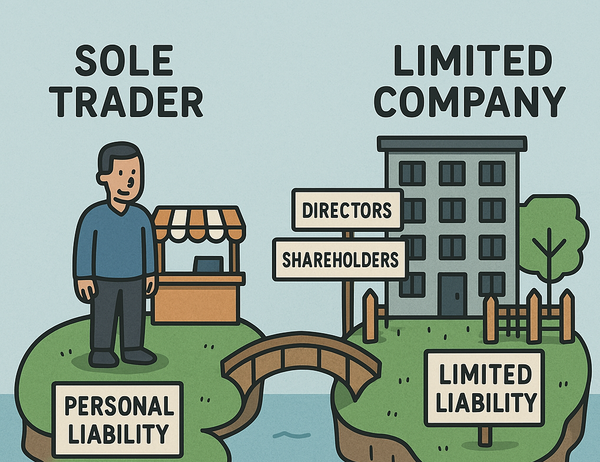Optimal salary for a company director - 2018 update
It’s that time of year when we need to look at the level of salary that company directors should be paying themselves from 6th April.
As in previous years, the main question is whether to pay a salary up to the Personal Allowance level or whether to pay a salary to the level at which National Insurance kicks in. We would generally recommend the second option to reduce administration. TL;DR: if the director has no other income and the Employment Allowance will be used up against other staff salaries then the best option would be for the director to be paid a salary of £8,424 (£702 per month). This should be topped up with £37,926 of dividends.
If the director is owed money by the company however they could also charge interest on their loan account so this may be an additional consideration for some. In the following it is also assumed the director wishes to stay below the higher rate tax band threshold for personal income tax. It is also assumed that they have no student loan balance, are not caught by IR35 and have a full personal allowance. It is assumed they are UK resident and have no other income, capital gains and there is no relief from tax to claim such as gift aid or pension payments.
Employment Allowance
A key factor on the level of salary a director should get is whether the employment allowance is available for that director or not. The Employment Allowance was increased to £3,000 from £2,000 in 2016/17. But HMRC announced that from 2016/17 onwards the Employment Allowance would not be available to companies where the only employee paid earnings above the Secondary Threshold for Class 1 National Insurance contributions is the director. This means that companies with several employees, where the director is the only employee paid above the Secondary Threshold, will not be eligible for the Employment Allowance. Deliberately avoiding this restriction by adding a spouse to the payroll to meet the criteria will be open to challenge from HMRC.
However, if the spouse genuinely works in the business, then the company should be able to claim the Employment Allowance, subject to them having earnings above the Secondary Threshold for Class 1. If a company has two directors then entitlement to the allowance is maintained provided both of them are paid above the secondary threshold, and for directors the annual secondary threshold is £8,424 for 2018/19 (or pro-rata if the directorship began after the start of the tax year) would need to be applied to ensure the criteria is met.
In summary you can’t claim if:
- you’re the director and the only paid employee in your company
- you employ someone for personal, household or domestic work (like a nanny or gardener) - unless they’re a care or support worker
- you’re a public body or business doing more than half your work in the public sector (such as local councils and NHS services) - unless you’re a charity
- you’re a service company working under ‘IR35 rules’ and your only income is the earnings of the intermediary (such as your personal service company, limited company or partnership).
I you can claim the allowance there are three basic options to consider:
- claim the Employment Allowance
- take a salary up to the NI Primary threshold
- a tailored option where the director has other income or could generate interest to be paid from the limited company
Option 1: Claim the employment allowance
Where a director has no other income and the Employment Allowance will not be used up against other staff salaries then the most tax efficient option is to take a salary up to the Personal Allowance of £11,850 (£987.50 per month). The £11,850 salary will be tax free for the director, however Employee’s National Insurance of (£11,850 - £8,424 x 12%) £411.12 will be due. This is offset by a Corporation Tax saving of £11,850 - £8,424 x 19% = £650.94 (compared to paying a salary up to the NIC threshold), giving an overall saving of £239.82
Take an annual gross salary of £11,850 which is the standard tax free personal allowance for 2018/19.
This leaves you £34,500 of dividends to take. There will be some personal tax to pay on these though, as the first £2k is tax free but after that is charged at 7.5% tax:-
| Gross salary | £11,850 | |
| Dividends | £34,500 | |
| Total | £46,350 | |
| Class 1 Employee | (£411) | |
| Dividend tax | (£2,438) | £34,500 less £2,000 = £32,500 x 7.5% |
| Cash | £43,501 |
Keep in mind however that dividends taken above the higher tax band will be taxed at 32.5%. And interactions with the child benefit charge, personal allowance withdrawal limit and the 37.5% tax band may occur where remuneration exceeds the above.
Option 2: Take a salary up to the NI Primary threshold
If the director has no other income and the Employment Allowance will be used up against other staff salaries then the best option would be for the director to be paid a salary over the Lower Earnings Limit but under the Primary Threshold of £8,424 (£702 per month).
This leaves you £37,926 of dividends to take. As with option 1, there will be some personal tax to pay on these:-
| Gross salary | £8,424 | |
| Dividends | £37,926 | |
| Total | £46,350 | |
| Class 1 Employee | NIL | |
| Dividend tax | (£2,438) | £37,926 less £5,426 = £32,500 x 7.5% |
| Cash | £43,912 |
*As you are taking £8,424 of salary this leaves almost £3,426 of dividends that are in the tax free personal allowance, as well as the £2k tax free for the dividend allowance.
The net cash after income tax and employees NI is slightly higher in option 2 than option 1 by £411, however this doesn’t factor in the additional corporation tax you save of £650.94 (£11,850 - £8,424 x 19%) on the higher Gross Salary in Option 1.
Option 2 also has the added benefit of reduced administration as no NI needs to be paid to HMRC.
Option 3: A tailored option
If the director has other income then a more tailored approach is required and one needs to consider the level and type of the other income, and also take into account whether the Employment Allowance will be used up against other staff salaries. Also, one should keep in mind that if the director is claiming the remittance basis, he will have lost the Personal Allowance and the benefit of a salary becomes then questionable.
But not everything is tax related and other considerations need to be taken into account. For example, it might make sense to pay a salary to a level which would preserve the director’s NI contribution record and would protect State Pension rights (£6,032 per annum for the 18/19 tax year).
A few of the possible tax planning options to consider are listed below:
- Transfer shares to spouses to take advantage of the dividend allowance
- Set up a rental agreement with your company for claiming ‘use of home as office’ expenses
- Make pension contributions from the company
- Extract money as interest income from the company
But tax calculations involving savings income are now very complicated. Even HMRC can't do the calculation properly in some instances and requires tax payers to files their returns on paper in those cases. Trying to bring tax to the very minimum might not actually be practical. But it's important to understand all the available options and their consequences, even if one decides to no use all of them.



